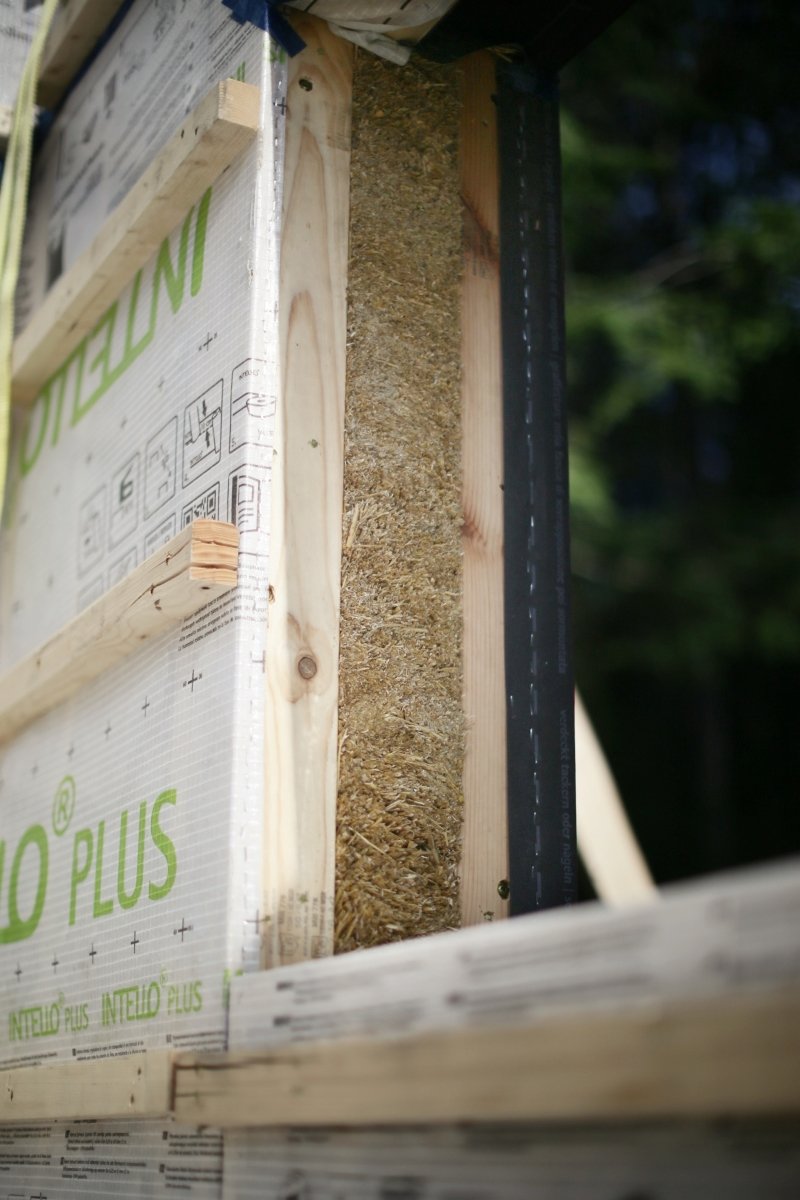Beyond the bale: High-performance straw building panels
Croft’s prefabricated, home-grown earth-friendly roof and wall panels are built to meet the specific dimensional requirements of each building project, minimizing waste. Courtesy photo.
Maine company crafts high-performance building panels from a low-carbon material.
By Tim King
IN THE CLASSIC CHILDREN’S STORY The Three Little Pigs, the first little pig’s house was made of straw—and quickly succumbed to the huffing and puffing of the Big Bad Wolf.
Croft’s super-compressed straw walls are highly insulated, vapor open and designed to last for generations. Courtesy photo.
Today, that little pig might well have stayed safe and sound in its house no matter how hard the wolf blew—if the house had been built with the densely packed, insulated straw panels manufactured by Croft L3C, a company in Rockland, Maine.
While homes have been constructed using straw bales for decades, Croft has created a patent-pending compression process that enables them to manufacture high-density, carbon-sequestering, durable straw-filled building panels that provide, says founder Andrew Frederick, “an exceptional level of fire resistance, carbon storage, and maintains straw’s naturally thermally insulating and vapor-open qualities.”
“The Croft Haus system has roots in straw-bale building, which has been considered one of the lowest-impact ways to build for a long time,” says Steve Konstantino, of Performance Building Supply in Portland. “Straw is typically a ‘waste’ product made from the production of grains. It stores carbon well and is also generally renewable.”
In other parts of the world, pioneering companies such as Durra Panel®, ModCell®, STRAWTEC and EcoCocon have built with straw-based, SIPs (structural insulated panels) since the early 2000s. But Croft is the first Maine company focused on supplying the New England region with these carbon-capturing panels.
On its own, straw is not a particularly strong insulator; it takes a lot to deliver the insulating R-values that high performance builders are committed to achieving for their customers. But Frederick feels this is a good thing: “Because straw is not a thermal superstar, there’s a clear incentive to use more of it. …the more straw we use, the more carbon gets stored, and the less that is released into the atmosphere. In that sense, the more we build [using straw], the greater the benefit is to the planet.”
Straw is also very slow to decompose, so each year, after grain harvests, approximately 200 million tons of waste straw are burned in the U.S., emitting greenhouse gases into the atmosphere. So, the more straw that can be put to good uses, like insulation, rather than being burned, the better.
Croft’s BIG IDEA
Croft’s ethos is to enable more energy-efficient homes to be built using carbon-sequestering, natural materials (i.e., straw) found locally. “Our work is…deeply integrated into the land and the whole raison d’être of Croft is carbon capture,” says Frederick. And in a nod to Michael Pollan’s famous line from An Eater’s Manifesto (“Eat food. Not too much. Mostly plants.”), Croft’s motto clarifies their intention: “Build shelter. Not too big. From mostly plants.”
A LOCAL RESOURCE THAT CAPTURES A LOT OF CARBON—AND FAST
Why did Frederick choose straw in the first place? To begin with, it’s a renewable resource that “locks up” passively captured atmospheric carbon for the lifetime of the building. This means that the carbon absorbed by the plant while it’s alive stays in the straw, rather than being released back into the atmosphere when it decomposes naturally. Straw also compares favorably to wood in terms of its carbon-capturing powers, says Frederick. “On a per-acre/per-year basis, using straw… for insulation yields about 20 times more carbon capture than wood-based options…such as cellulose.” He adds that the 100% bio-based materials that Croft uses in its buildings can capture up to 60 times more carbon than it takes to produce them. Speed and ease of production also make straw a good choice. “When you have to account for…the growth cycle of the crop, you find…[with] spruce, pine, or fir, it’s about 90 years. On the other hand, the growth cycle of straw is six months,” says Frederick.
Croft is also careful about where they source their materials, buying it from local producers committed to supplying stock free of pesticides, fungicides and other toxins. And because it comes from nearby farms, the CO2 cost of delivering it to their factory is far lower than if it had been shipped in from far away.
PACKED TO PERFORM
R-values measure how well building insulation prevents the flow of heat into and out of a home. The higher the R-value, the better the insulation performs. Thanks to the manufacturing methods they’ve developed, Croft’s panels are so tightly packed that they have R-values comparable to those of another carbon-sequestering material, cellulose.
The panels have other pluses: they are sealed on both sides with vapor-open but airtight fabric and have screening at the base to keep pests out. And unlike hay, straw contains nothing digestible, making it unappealing to mice and other rodents.
Prior to installation on site, Croft’s panels are wrapped to provide an air barrier, smart vapor control and reinforce the dense-pack straw. Courtesy photo.
THE AHA MOMENT: BETTER BUILT ISN’T ALWAYS BETTER FOR THE PLANET
Frederick recalls the idea for Croft first began to take shape during a presentation given by Heather Thompson at the 2019 passivhausMAINE annual conference. The Portland-based home builder (Juniper Design+Build) put up a slide comparing the amount of total carbon emitted by a regular “code-built” home containing dense-pack cellulose insulation and wood to that of a high-performance home built with high-carbon materials: foam insulation, vinyl siding, plastic, lots of concrete. The data illustrated a simple yet counterintuitive idea: building a high-performance home using high-carbon-footprint materials like these isn’t necessarily a good thing for carbon emissions when you factor in the true costs of producing and transporting all the material it takes to build it.
When completed, a net-zero energy home will ultimately produce the same amount of energy that its occupants consume each month. Until recently, though, the carbon costs associated with creating the building have been largely overlooked. These include raw material extraction, product manufacturing and transportation of goods. And there also hasn’t been an accurate way to measure these costs. Low-carbon construction and straw-built home expert Chris Magwood called this “the carbon elephant in the room” back in 2013, when the focus in the sustainable building industry was exclusively on making buildings more energy efficient.
Frederick agrees that increased energy efficiency is an important goal. But how we get there may matter more, when examined through the lens of carbon reduction goals. He feels that capturing carbon is critical to solving the climate crisis: “Extracting the raw ingredients, manufacturing and transporting those materials come at a dear price to the environment, and that cost has been left out of ‘green building’ standards up until now. … We are, first and foremost, a carbon-capture company; we just happen to use architecture as the storage medium.”
CONSTRUCTION CONUNDRUM: HOW TO BUILD BETTER?
More and more, people in the high-performance building industry realize that they’ve been creating more CO2 even as they strive to construct tight, super-insulated homes that consume very little energy and are comfortable to live in. This understanding has led to a growing interest in bio-based materials, such as mass timber, in lieu of concrete and steel, and dense-pack cellulose insulation instead of petroleum-based foam. Maine home designer Michael Maines also sees a future for using even more kinds of bio-based materials, such as straw, in modern construction processes: “For those interested in building with the lowest levels of embodied carbon, which I believe should really be called ‘upfront carbon’ emissions, I think straw has potential.”
More good news: now tools like the Embodied Carbon in Construction Calculator (EC3) enable anyone in the AEC (architecture, engineering and construction) industry to precisely and easily calculate the upfront carbon emissions of construction materials, making light work of a previously onerous task.
POWER OF THE PANEL
More effective and efficient methods of constructing high-performance buildings are also gaining traction in the U.S., like designing and building high-quality modular panels in off-site, modern facilities, which drives performance up and prices down (see “Special Delivery: Rethinking Modular Construction” in the Spring 2017 issue of Green & Healthy Maine HOMES). Michael Maines agrees. “For high-performance builders, I think panelized systems of all types are very useful, as they allow a small crew to do the work of a larger crew.”
RIGHT PLACE, RIGHT TIME
As the concept of Embodied Carbon (EC) continues to garner attention, more and more people seem to be taking a closer look at straw. And that’s good news for Croft. “The market demand is absolutely overwhelming at this point,” says Frederick.
The company is completing its third building project and already has work scheduled out for the next three years. To meet this demand, the company anticipates it will be making significant investments in its production capabilities later in the year. If all goes according to plan, based on Croft’s backlog of projects, Frederick estimates the company could produce 20 million square feet of panels to fulfill these orders, (the equivalent of about 460 acres or 347 football fields), capturing 120,000 tons of atmospheric CO2.
Croft’s great potential has not gone unnoticed. In June 2021, it was the recipient of a $50,000 grant from the nonprofit, state-funded Maine Technology Institute (MTI), and Frederick used the funds to update Croft’s panel compression station, making the panels less costly and easier to produce, and thus a more viable construction option for more homebuilders.
As demand grows for lower-carbon building materials, innovative products like Croft’s will help shrink the carbon footprints of new homes, so, in a manner of speaking, it’s time to “make hay while the sun shines” and make the most of all the advantages companies like this have to offer.
Image excerpted from the Builders for Climate Action Whitepaper #1, available at buildersforclimateaction.org.
This article appeared in the Spring 2022 edition of Green & Healthy Maine HOMES. Subscribe today!
Find Maine experts that specialize in healthy, efficient homes in the Green Homes Business Directory.







